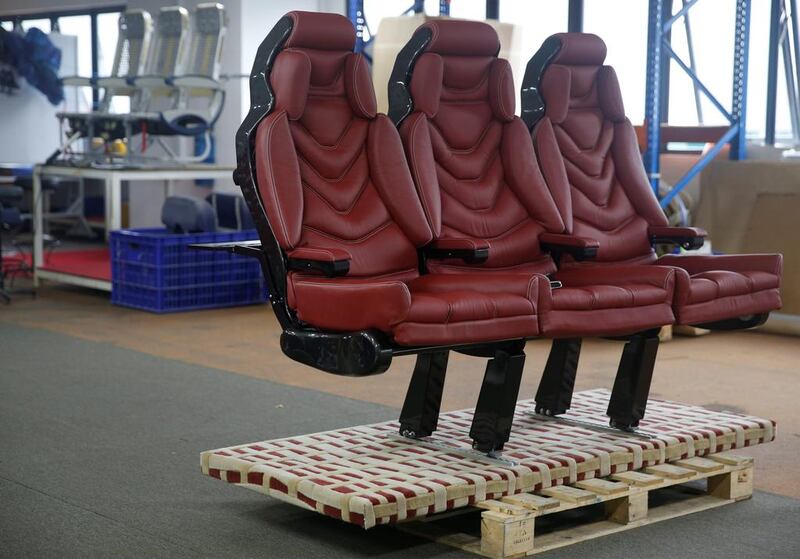Some start-ups are taking on one of air travel’s last undisrupted bastions – the economy-class cabin.
While first and business-class travellers have long enjoyed comfort upgrades, there has been less attention to innovation at the rear of the plane.
“We want to make travel memorable and comfortable for all of us, not just the top 1 per cent,” said Alireza Yaghoubi, the founder of Singapore-based AirGo, to pitch his superlight economy-class seat.
He is not alone. Half a dozen firms are pitching something similar, wanting to make seats more comfortable, improve cabin lighting, make it easier to use and charge mobile devices on flights and even upgrade the humble food trolley.
They are trying to penetrate an industry eyeing significant growth on the back of strong jetliner demand, illustrated by this week’s US$6.4 billion deal for Rockwell Collins to take over B/E Aerospace, an interiors manufacturer.
Tough ask
Persuading the airline industry to upgrade, however, is a tough ask. In a fiercely competitive market and with single-digit margins, carriers have gone as far as they can with economy-class innovation, says Anthony Harcup of Acumen, a UK design house that works with plane makers and airlines.
“Right now, we’ve designed ourselves into a corner with the current economy format,” he says. “It’s about as tight and tiny as you’re going to get it. So something has to give and it’s difficult to see what that is.”
Acumen, which designed the world’s first flat bed for British Airways 20 years ago, has had only two of its in-cabin concepts lie unused: both involved re-thinking the form and layout of economy-class seats.
But that is not stopping a new generation of outsiders working with new materials and technologies to make economy class, if not luxurious, at least more bearable.
Comfort
Mr Yaghoubi, for example, vowed to do something about airline seats when he flew back to his home country on its national airline and noticed the seats had not been replaced since the plane was bought 40 years ago. “Actually, they were quite a lot more comfortable” than today’s seats, he says.
The latest prototype of his seats, he says, offers a wider back rest by having smaller elbow rests that fold down rather than up, and has better head support. Extra leg room is created by moving the literature pocket and improving the seat posture to have people sit more upright.
But these firms realise they cannot just pitch their seats on comfort alone.
The UK-based Rebel.Aero, for example, promises to speed up boarding and integrate a child seat by letting the seat slide upwards, like an inverted cinema seat. This frees up space for passengers to move in and out and stretch their legs. The founder Gareth Burks says he is halfway through getting certification and has delivered sample seats to some aircraft manufacturers.
AirGo is counting on airlines liking that its seats are made of carbon fibre composites, where fibres are braided like hair, creating a hollow structure that halves their weight.
Others are experimenting with other materials. France-based Expliseat has announced Air Tahiti as the first customer for its titanium seats, freeing up the equivalent weight of up to four passengers.
And UK-based FlightWeight has redesigned the food trolley, ditching the usual aluminium casing for mostly flax seed waste, volcanic rock, sugar and water – making it almost a third lighter.
Expensive
Changing consumer habits also offer airlines a chance to shed weight.
Most passengers would prefer to use their own mobile device, says Fred Cleveland, a former vice president at American Airlines and now an adviser to PricewaterhouseCoopers. This allows some airlines to ditch some expensive and heavy wiring and hardware and convert seats into charging stations.
Cobalt Aerospace, another UK-based design firm, offers ways to customise seats, including wireless charging in tray tables and arm rests.
This could be bad news for suppliers of in-flight entertainment systems such as Panasonic. Singapore Airlines’ budget subsidiary Scoot has already abandoned traditional seat-back consoles in favour of pre-loaded iPads.
But there are obstacles for start-ups.
A lot has already been spent by companies such as Germany’s Recaro and France’s Zodiac Aerospace on making seats as light as possible by using advanced materials. Many leading airlines are already installing them.
But production bottlenecks in the interiors industry highlight the challenges it faces in keeping up with demand and may make airlines wary of gambling on untested suppliers.
Hurdle
Persuading airlines to spend more is not easy, says Martin Darbyshire of the UK-based Tangerine, which customised the headrests in Cathay Pacific’s A350 economy seats. Cathay was willing to make the changes, he says, because it makes money from economy. “But for most other airlines the costs are prohibitive.”
Maybe the biggest hurdle is certification.
There are strict rules about what can and cannot be done and any tweaks require approval. When one airframe maker reduced the weight of the tracks where seats slot in, it found itself having to restore all the saved weight to ensure the design met certification requirements, says Mr Darbyshire. “It becomes a vicious circle.”
Part of the problem is that while passengers grumble about economy-class travel, they are sensitive to price and do not differentiate much on features, says Mr Harcup.
Unlike booking a hotel, he says, where cost is just one of many metrics a customer looks at – internet access, parking, a pool – when it comes to the airline seat “the passenger is confronted with one metric and that’s cost. So it’s no wonder we’re in the situation we’re in.”
* Reuters
business@thenational.ae
Follow The National's Business section on Twitter






